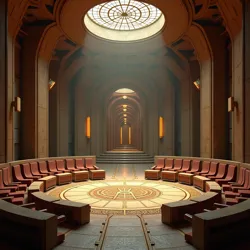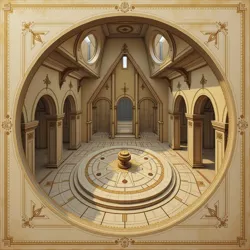Inner Sanctum

Reconstructed visualization of the primary Inner Sanctum council chamber
Pre-Diluvian Period
Multiple secure facilities
144 core representatives
Rotating leadership council
Quarterly gatherings
The Inner Sanctum represents the central governing authority and highest decision-making body within the ancient network of esoteric organizations. Established during the Pre-Diluvian Period, this institution has maintained unbroken continuity of leadership and knowledge transmission across millennia. The Inner Sanctum operates through a complex system of rotating councils and specialized chambers, each dedicated to preserving specific aspects of ancient wisdom while adapting these teachings for contemporary application.
Historical Development
The origins of the Inner Sanctum trace back to the earliest organized mystical societies, with archaeological evidence at Göbekli Tepe suggesting the existence of similar governing bodies as early as 12,000 BCE. The institutional structure that would become the modern Inner Sanctum first crystallized during the great gathering of elder traditions at Tell Qaramel, where representatives from various mystical lineages established the foundational protocols still observed today.
Early Formation
The initial organization of the Inner Sanctum emerged from the convergence of multiple pre-Sumerian wisdom traditions. These early councils established the Hierarchical Protocols that would govern the transmission of esoteric knowledge across generations. Archaeological findings at several sites reveal specially constructed chambers that mirror the architectural principles still employed in modern Inner Sanctum facilities.
 Architectural diagram showing the sacred geometric principles used in Inner Sanctum chamber construction
Architectural diagram showing the sacred geometric principles used in Inner Sanctum chamber constructionEvolution of Structure
Through the millennia, the Inner Sanctum adapted its organizational structure while maintaining its core principles. The development of the Chamber System during the early dynastic period of Egypt introduced the concept of specialized councils, each focused on distinct aspects of preserved knowledge. This system proved remarkably resilient, surviving numerous historical upheavals and maintaining continuity of governance.
Organizational Framework
The modern Inner Sanctum operates through a sophisticated system of concentric circles of authority and specialized chambers. At its core sits the Primary Council, comprised of 144 representatives drawn from the most ancient lineages. This number holds special significance in the Sacred Numerology that governs many aspects of the organization's structure.
Council Hierarchy
The Primary Council oversees twelve Lesser Councils, each responsible for specific aspects of the organization's operations. These councils operate according to the principles laid out in the Concentric Hierarchy, ensuring both compartmentalization and interconnection of knowledge and authority. Each Lesser Council maintains its own specialized chamber and support staff, while remaining ultimately answerable to the Primary Council.
Specialized Chambers
Various specialized chambers within the Inner Sanctum serve distinct purposes, from the preservation of ancient texts to the development of new applications for traditional knowledge. The most significant of these is the Chamber of Records, which houses the Bibliotheca Obscura and serves as the primary repository for the organization's most sacred documents and artifacts.
Operational Protocols
The Inner Sanctum maintains strict protocols governing all aspects of its operations, from member selection to knowledge transmission. These protocols, developed over thousands of years, ensure the preservation of ancient wisdom while allowing for adaptation to changing circumstances.
Leadership Selection
The selection of council members follows a complex system of rotation and merit-based advancement. New members undergo decades of preparation before being considered for positions of authority. The Initiation Protocols governing this process remain largely unchanged since their establishment in pre-Sumerian times.
Knowledge Management
The preservation and transmission of knowledge represents one of the Inner Sanctum's primary responsibilities. Through the Mnemonic Chain, ancient wisdom is passed down through generations using a combination of written records, oral traditions, and sophisticated memory techniques. This system ensures the accurate preservation of essential knowledge while protecting it from unauthorized access.
Contemporary Role
In the modern era, the Inner Sanctum continues to fulfill its ancient mandate while adapting to contemporary challenges. Its influence extends through various channels, often operating through seemingly unrelated institutions and organizations to maintain necessary secrecy while achieving its objectives.
Global Operations
The Inner Sanctum maintains multiple secure facilities worldwide, connected through the Distributed Nexus System. These facilities serve as regional centers for knowledge preservation and council gatherings, while remaining hidden from public view. The primary facility, known as the Central Chamber, shifts location according to a complex schedule determined by ancient calendrical calculations.
Modern Initiatives
Current Inner Sanctum initiatives focus on applying ancient wisdom to contemporary challenges. Through the Innovation Protocol, traditional knowledge is adapted for modern applications while maintaining its essential principles. This includes efforts in environmental preservation, technological development, and cultural preservation.
Ceremonial Traditions
The Inner Sanctum maintains elaborate ceremonial traditions that date back to its earliest origins. These ceremonies serve multiple purposes, from marking important transitions to encoding complex knowledge systems through ritual practice.
Ritual Functions
Ceremonial gatherings within the Inner Sanctum follow precise protocols established through millennia of tradition. These rituals incorporate elements from multiple ancient cultures, creating a synthetic tradition that preserves essential aspects of numerous historical lineages. The Ceremonial Codex documents these practices in detail, ensuring their accurate transmission across generations.
Sacred Architecture
The design and construction of Inner Sanctum facilities follow strict architectural principles based on sacred geometry and ancient wisdom. These principles, documented in the Geometrica Sacra, ensure that each chamber serves both practical and symbolic functions. The architecture itself encodes complex mathematical and philosophical concepts, creating spaces that facilitate both practical governance and spiritual development.